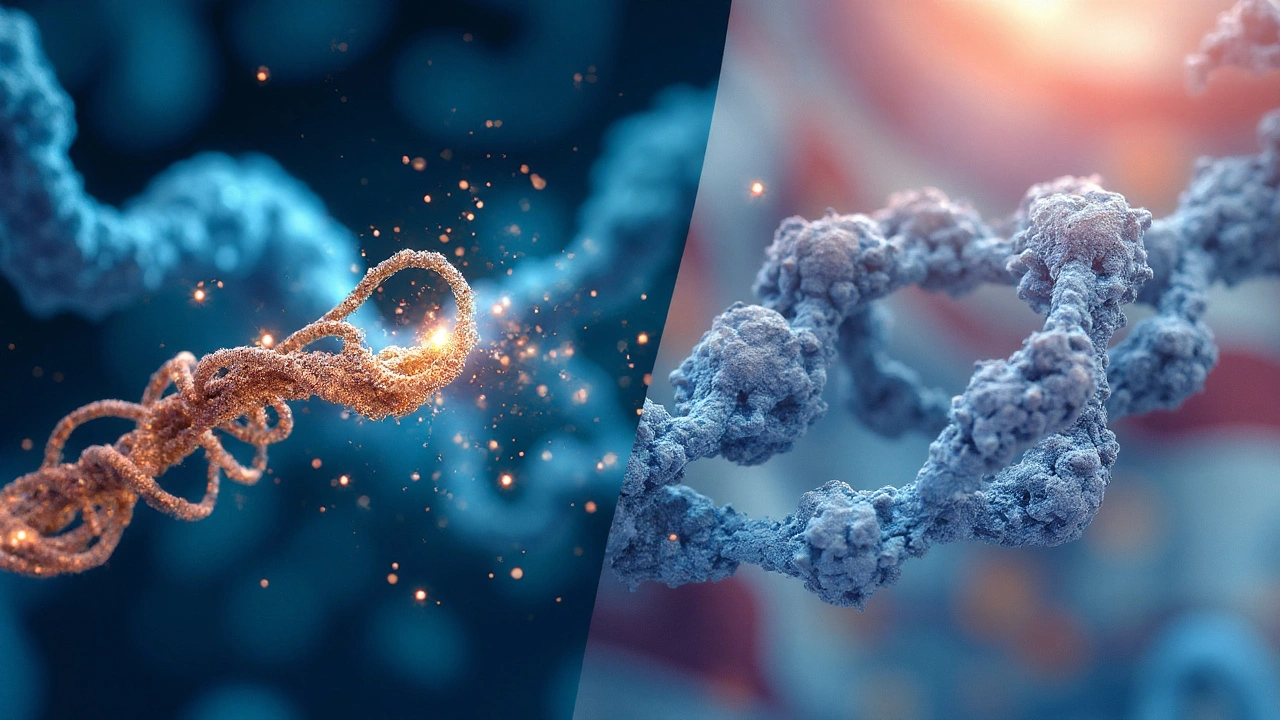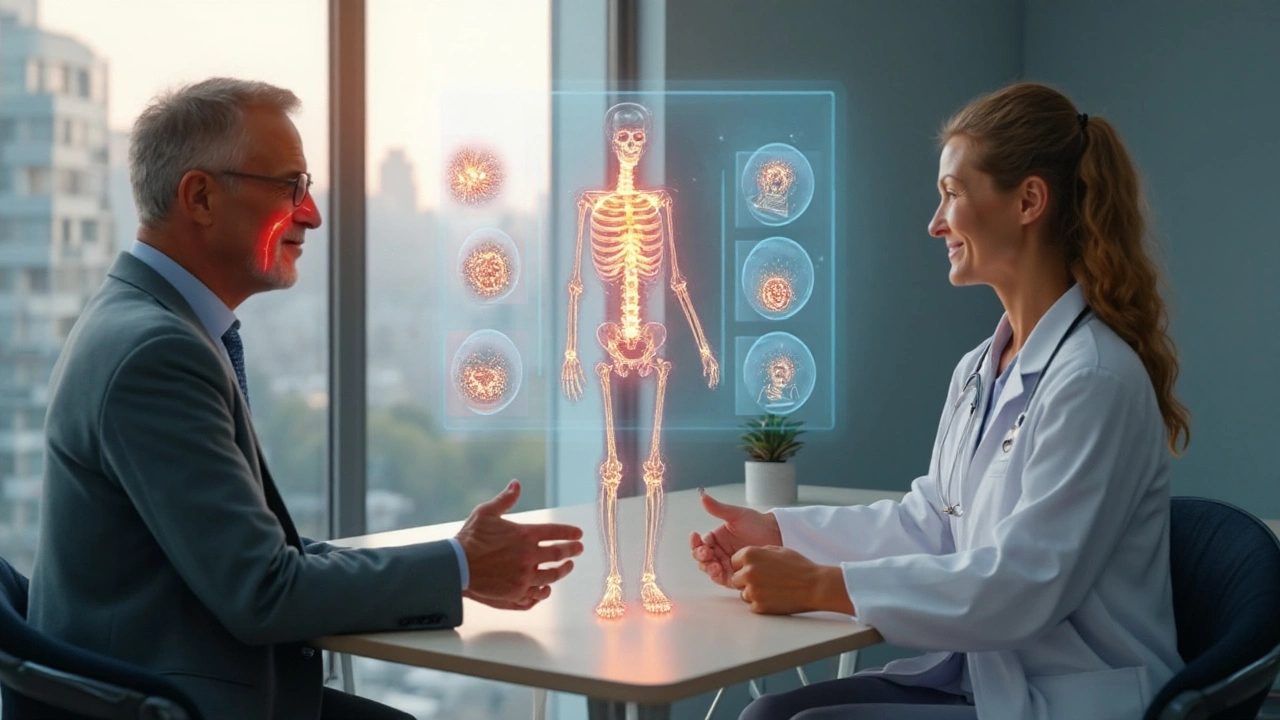Parathyroid hormone is a peptide hormone produced by the parathyroid glands that regulates calcium homeostasis and bone remodeling. In the context of osteoporosis treatment, recombinant forms of this hormone act as powerful bone‑building agents, offering a distinct alternative to anti‑resorptive drugs.
Why Osteoporosis Needs a New Approach
Osteoporosis is a systemic skeletal disease marked by reduced bone mineral density (BMD) and micro‑architectural deterioration, leading to increased fracture risk. Traditional therapies such as bisphosphonates mainly slow bone loss by inhibiting osteoclast activity. However, many patients still experience fractures despite prolonged use, indicating a need for anabolic strategies that actually build bone.
Bone Remodeling: The Cellular Conversation
The bone remodeling unit consists of osteoblasts, the cells that form new bone matrix, and osteoclasts, which resorb old bone. Parathyroid hormone exerts a dual effect: intermittent exposure stimulates osteoblast differentiation and activity, while continuous high levels favor osteoclast‑mediated resorption. This dose‑dependent paradox forms the scientific basis for using synthetic PTH analogs as anabolic agents.
Key PTH Analogs in Clinical Practice
Two recombinant forms dominate the market:
- Teriparatide is a 1‑34 fragment of native PTH, approved in 2002 for patients with severe osteoporosis. It is administered once daily via subcutaneous injection.
- Abaloparatide is a 34‑amino‑acid peptide that shares 89% homology with PTH but binds a different conformation of the PTH‑1 receptor, offering a slightly lower hypercalcemia risk. It entered the US market in 2017.
Both agents have demonstrated significant increases in BMD at the lumbar spine (up to 10% over 18 months) and reductions in vertebral fracture incidence.
How PTH Therapy Differs From Traditional Anti‑Resorptives
| Attribute | Teriparatide / Abaloparatide | Bisphosphonates |
|---|---|---|
| Primary Mechanism | Anabolic - stimulates osteoblasts | Antiresorptive - inhibits osteoclasts |
| Typical Dosing Frequency | Daily (Teriparatide) or weekly (Abaloparatide) | Weekly, monthly, or yearly oral/IV |
| FDA Approval Year (US) | 2002 (Teriparatide), 2017 (Abaloparatide) | 1995 (Alendronate), 2007 (Zoledronic acid) |
| Major Side Effects | Transient hypercalcemia, nausea | Gastrointestinal irritation, osteonecrosis of the jaw |
| Typical Treatment Duration | Maximum 24 months | Indefinite, with periodic drug holidays |
These differences matter when choosing a regimen for a patient who, for example, cannot tolerate oral bisphosphonates due to esophageal irritation.

Assessing Patients: Tools and Scores
Before initiating PTH therapy, clinicians evaluate fracture risk using the FRAX score, which incorporates age, gender, prior fractures, and BMD measured by dual‑energy X‑ray absorptiometry (DXA). Candidates typically have a 10‑year major osteoporotic fracture risk >20% or a recent vertebral fracture.
Vitamin D status and calcium intake are also screened, because adequate levels are prerequisite for PTH‑driven bone formation. Serum 25‑hydroxy‑vitamin D < 20ng/mL often warrants supplementation before therapy.
Practical Considerations for Clinicians
- Injection Technique: Patients self‑administer subcutaneous injections in the thigh or abdomen. Proper site rotation reduces local irritation.
- Monitoring: Serum calcium and creatinine are checked at baseline, 1 month, and quarterly thereafter to catch hypercalcemia early.
- Transition Strategies: After the 24‑month PTH course, many physicians switch patients to a bisphosphonate or denosumab to preserve gains.
- Cost and Access: PTH analogs are more expensive than generic bisphosphonates; insurance prior‑authorization is common. Patient assistance programs exist through manufacturers.
The U.S. Food and Drug Administration (FDA) mandates that treatment stops after two years due to limited long‑term safety data, a restriction that shapes clinical pathways.
Future Directions: New Anabolic Agents
Research is expanding beyond PTH fragments. Romosozumab, a monoclonal antibody that inhibits sclerostin, combines anabolic and anti‑resorptive effects, showing even greater BMD gains in head‑to‑head trials with teriparatide. Gene‑editing approaches targeting the PTH‑1 receptor are in early‑phase studies, hinting at once‑monthly oral anabolic options.
Nonetheless, the proven track record of PTH analogs-especially in high‑risk patients-keeps them central to osteoporosis management guidelines.
Key Takeaways
- Parathyroid hormone analogs are the only FDA‑approved anabolic osteoporosis drugs, directly stimulating osteoblasts.
- They are most effective in patients with severe BMD loss or recent fractures, especially when anti‑resorptives have failed.
- Therapy requires diligent monitoring of calcium, vitamin D status, and adherence to the 24‑month limit.
- Transitioning to anti‑resorptive therapy after the anabolic phase helps maintain bone gains.
- Emerging agents like romosozumab may soon broaden the anabolic toolbox.

Frequently Asked Questions
How does parathyroid hormone actually build bone?
Intermittent exposure to a PTH analog triggers the PTH‑1 receptor on osteoblast precursors, boosting their proliferation, differentiation, and survival. The net result is increased collagen production and mineral deposition, raising bone mineral density.
Who is a good candidate for PTH therapy?
Patients with a T‑score ≤‑2.5, a recent vertebral fracture, or a FRAX 10‑year major fracture risk >20% are typical candidates. Those who cannot tolerate oral bisphosphonates or have contraindications to anti‑resorptives also benefit.
What are the most common side effects?
Mild nausea, dizziness, and transient hypercalcemia are the most reported. Serious complications like osteosarcoma have been observed only in animal studies; the human risk is extremely low.
Can PTH therapy be combined with bisphosphonates?
Concurrent use blunts the anabolic effect because bisphosphonates suppress bone turnover. The recommended strategy is to finish the PTH course, then switch to a bisphosphonate or denosumab to preserve the newly formed bone.
How long does a typical treatment last?
The FDA limits teriparatide and abaloparatide to a maximum of 24 months total exposure, after which a transition to an anti‑resorptive agent is advised.
Is there a difference between teriparatide and abaloparatide?
Both are anabolic, but abaloparatide binds a slightly different receptor conformation, leading to a lower incidence of hypercalcemia and a once‑daily injection schedule similar to teriparatide.
What monitoring is required during therapy?
Baseline and periodic serum calcium, phosphate, creatinine, and 25‑hydroxy‑vitamin D levels are recommended. DXA scans are repeated at 12‑month intervals to track BMD response.


Stephen Gachie
September 25, 2025 AT 01:01The paradox of bone remodeling mirrors the duality of existence; intermittent PTH nudges the skeletal canvas toward renewal while continuous exposure erodes it. When the hormone is delivered in measured bursts it awakens dormant osteoblasts, prompting them to lay down fresh matrix. In contrast, a steady flood of signal drives the resorptive army, tipping the balance toward loss. Thus the therapeutic art lies in timing, not merely dosage. This insight echoes ancient notions that balance, not excess, begets health.
Sara Spitzer
September 25, 2025 AT 14:55While the overview correctly lists teriparatide and abaloparatide, it omits the fact that real‑world adherence rates for daily injections hover around 60 %. Moreover, the claim that PTH analogs increase lumbar BMD by “up to 10 %” glosses over the variability seen across studies; many trials report gains in the 5‑7 % range. The side‑effect profile is also understated – hypercalcemia, though “transient,” can be symptomatic and requires monitoring. In short, the article paints an overly rosy picture without acknowledging the practical hurdles.
Jennifer Pavlik
September 26, 2025 AT 04:48If you’re new to bone health, think of PTH therapy like a construction crew that comes in after a quake. The hormone tells the builders (osteoblasts) to start laying fresh bricks, while the demolition crew (osteoclasts) steps back. It’s a good option when pills that only slow loss aren’t enough. Just remember to check calcium levels and vitamin D before starting, and keep the injections regular.
Jacob Miller
September 26, 2025 AT 18:41Honestly, most patients don’t read the fine print and end up paying out‑of‑pocket for a treatment that sounds “miraculous” but delivers modest gains. If you’re not willing to navigate insurance hoops and daily injections, you might be better off with a well‑chosen bisphosphonate and some lifestyle tweaks. The hype around anabolic drugs often overshadows the simple truth: consistency beats flash.
Anshul Gandhi
September 27, 2025 AT 08:35Don’t be fooled by the pharma‑driven narrative that PTH analogs are the “future” of osteoporosis. The same companies that pushed high‑dose vitamin D supplements now push pricey injections, all while lobbying to keep generic bisphosphonates off formularies. Remember, the 24‑month cap isn’t just a safety measure; it’s a way to create perpetual demand for the next “innovation.”
Emily Wang
September 27, 2025 AT 22:28Even with the adherence challenges you mentioned, many patients still see real improvements when they stick to the schedule. Think of it as a marathon, not a sprint – the early weeks can feel tough, but the payoff in bone strength is worth the effort. Keep the injection routine, monitor labs, and celebrate each small BMD gain.
Hayden Kuhtze
September 28, 2025 AT 12:21Oh sure, because every “big pharma” plot is as obvious as a billboard. Meanwhile, the chemistry that lets PTH analogs mimic our own hormone is genuinely impressive. Perhaps the real conspiracy is the lack of funding for cheap, effective public health measures.
Craig Hoffman
September 29, 2025 AT 02:15Quick tip: when switching from teriparatide to a bisphosphonate, give the bone a few weeks off the anabolic drug before starting the anti‑resorptive. This “drug holiday” helps lock in the new bone formed.
Terry Duke
September 29, 2025 AT 16:08Great discussion! 😊 The data on PTH analogs really shows they can turn the tide for high‑risk patients. Consistent monitoring of calcium levels is essential and helps catch hypercalcemia early. Vitamin D status should be optimized before starting any anabolic therapy. Daily injections can feel like a chore at first but become routine with a good reminder system. Many patients find using a phone alarm or a pill box helpful. Some even schedule the injection after brushing teeth to build habit. The BMD measurements typically rise within the first six months of treatment. A rise of 5‑7 % in lumbar spine density is common and clinically meaningful. Fracture risk estimates drop noticeably after the first year. It’s also important to maintain weight‑bearing exercise alongside medication. Walking, resistance training, and balance work all contribute to bone health. Nutrition matters; adequate protein and calcium intake support the anabolic process. Patients should keep a log of injection dates and lab results for their clinician. Finally, after the 24‑month limit, transitioning to a bisphosphonate or denosumab preserves the gains made. Stay positive, stay informed, and keep up the good work! 🙌
Chester Bennett
September 30, 2025 AT 06:01Balancing anabolic and anti‑resorptive therapy requires a nuanced plan. Start with a PTH analog for up to two years, then evaluate BMD response. If gains are solid, transition to a bisphosphonate to maintain the new bone mass. Regular DXA scans at 12‑month intervals guide the next steps. Throughout, ensure calcium intake of 1000‑1200 mg daily and vitamin D levels above 30 ng/mL. This approach respects both the need for bone building and the safety of long‑term treatment.
Emma French
September 30, 2025 AT 19:55Stick to the monitoring schedule and you’ll avoid most complications.
Debra Cine
October 1, 2025 AT 09:48Don’t let the paperwork intimidate you – many manufacturers offer assistance programs that can cover most of the cost 😊. Reach out to your endocrinology office, ask about patient‑aid forms, and get the insurance folks on board. A little persistence pays off, and the bone benefits are worth it! 🌟
Rajinder Singh
October 1, 2025 AT 23:41Behold, the saga of skeletal renewal unfolds, where the humble peptide heralded from the parathyroid rises to challenge the tyranny of bone loss. In this dramatic tableau, each injection is a proclamation of hope, echoing through the marrow cavities like a clarion call to the dormant osteoblasts. Yet, as with any epic, there are perils – the lurking specter of hypercalcemia, the looming deadline of twenty‑four months, and the ever‑present bureaucracy that seeks to bind the hero’s destiny. Let us, therefore, applaud the bravery of those who venture upon this arduous path, for they embody the very spirit of perseverance against the relentless march of fragility.
Samantha Leong
October 2, 2025 AT 13:35I understand that managing a new injection schedule can feel overwhelming, especially when you’re already coping with other health concerns. It helps to set small, achievable goals each week, like preparing the injection site the night before or keeping a log of your calcium levels. Talking with a supportive healthcare provider can also ease anxiety and ensure you’re on the right track.
Taylor Van Wie
October 3, 2025 AT 03:28The American healthcare system should prioritize home‑grown, affordable treatments over foreign‑made, overpriced biotech drugs that line corporate pockets.
carlee Lee
October 3, 2025 AT 17:21Sharing knowledge across borders improves patient outcomes worldwide.
chuck thomas
October 4, 2025 AT 07:15Consider how the bone’s ability to remodel mirrors our own capacity for renewal; each day offers a chance to rebuild strength from within. By embracing therapies that stimulate growth rather than merely halt loss, we honor the body’s intrinsic wisdom. The challenge lies not just in the medication but in the mindset that supports consistent, proactive care.
Gareth Pugh
October 4, 2025 AT 21:08From the ancient philosophers to modern clinicians, the quest for a sturdy skeleton has always been a dance between destruction and creation. PTH analogs add a vibrant splash of anabolic paint to the otherwise muted canvas of bone health.
Illiana Durbin
October 5, 2025 AT 11:01When you finish the two‑year PTH course, remember to schedule a follow‑up DXA and discuss a suitable anti‑resorptive to lock in your gains.
Tyler Heafner
October 6, 2025 AT 00:55In conclusion, the judicious use of parathyroid hormone analogs, complemented by diligent monitoring and strategic transition to anti‑resorptive agents, constitutes a comprehensive approach to managing severe osteoporosis.